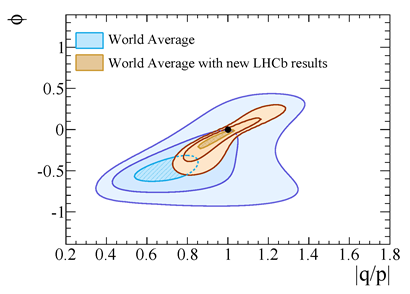[ x’2 = (5.5 ± 4.9)x10-5 ; y’ = (4.8 ± 1.0)x10-3 ]
[ AΓ(KK) = (-0.35 ± 0.62 ± 0.12)x10-3 AΓ(ππ) = (0.33 ± 1.06 ± 0.14)x10-3 ]
The LHCb Collaboration has reported recently new important results on charm physics.
(1) Ten months ago, the LHCb Collaboration presented the first observation of the D0-D0 oscillations in which the D0 matter mesons turn into their antimatter partners. Contrary to the B0-B0 and B0s-B0s oscillations in which the mesons turn into their antimatter partners many times during their lifetime, the D0-D0 oscillations are very slow, over one hundred times the average lifetime (see 7 November 2012 news for introduction). LHCb has now updated this result using the full 2011 and 2012 data set of 3 fb-1. The new result is 2.5 times more precise. The values parameterizing the oscillations, the so-called mixing parameters y’ and x’2, are shown above.
By now, CP violation, differences in the behaviour of matter and antimatter, has been observed in all oscillating neutral-meson (K0, B0, B0s) systems apart from the charm system. First evidence for charm CP violation (see 14 November 2011 news) has not been unambiguously confirmed to date (see 12 March 2013 news). The D0 mesons are the only mesons containing up-type quarks which undergo matter anti-matter oscillations (called also mixing) and therefore provide unique access to effects from physics beyond the Standard Model.
As part of the new analysis, LHCb has investigated whether there is a CP violating contribution to the oscillations, in contrast to the Standard Model expectation. This is done by investigating whether the oscillation parameters for mesons produced as D0 and D0 differ. Studying the D0 and D0 decays separately shows no evidence for CP violation and provides the most stringent bounds on the parameters (AD and |q/p| for experts) describing this violation from a single experiment.
(2) LHCb physicists measured the asymmetry AΓ of the inverse of effective lifetimes in decays of D0 and D0 mesons to the K– K+ and π–π+ final states. The measured values of the parameter AΓ shown above represent the world’s best measurements of this quantity, and are the first searches for CP violation in charm oscillations with sensitivity better than 10-3. They do not indicate CP violation, and show no difference in AΓ between the two final states.
The results of other experiments combined by the Heavy Flavor Averaging Group indicated a hint for possible non-zero values of the CP violation parameters (|q/p| and φ for experts). Both LHCb results presented above do not support this indication as seen in the image. The size of the contour with the new LHCb results is about a factor of two smaller in each of |q/p| and φ. They provide very stringent limits on the underlying parameters, thus constraining the room for physics beyond the Standard Model.
click the image for higher resolution
Read more in the LHCb presentations at the 6th International Workshop on Charm Physics Manchester, England, and in the paper here and here and also in the CERN Courier article.

